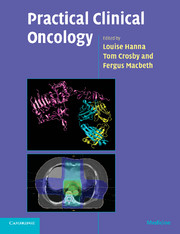Book contents
- Frontmatter
- Contents
- List of contributors
- Preface
- Acknowledgements
- Abbreviations
- 1 Practical issues in cytotoxic chemotherapy usage
- 2 Biological treatments in cancer
- 3 Hormones in cancer
- 4 Radiotherapy planning
- 5 Research in cancer
- 6 Oncological emergencies
- 7 Palliative care
- 8 Head and neck
- 9 Oesophagus
- 10 Stomach
- 11 Liver, gallbladder and biliary tract
- 12 Exocrine pancreas
- 13 Colon and rectum
- 14 Anus
- 15 Gastrointestinal stromal tumours
- 16 Breast
- 17 Kidney
- 18 Bladder
- 19 Prostate
- 20 Testis
- 21 Penis
- 22 Ovary
- 23 Body of the uterus
- 24 Cervix
- 25 Vagina
- 26 Vulva
- 27 Gestational trophoblast tumours
- 28 Lung
- 29 Mesothelioma
- 30 Soft tissue and bone tumours in adults
- 31 The lymphomas and myeloma
- 32 Central nervous system
- 33 Skin cancer other than melanoma
- 34 Melanoma
- 35 Thyroid
- 36 Neuroendocrine tumours
- 37 Cancer in children
- 38 Cancer of unknown primary
- 39 The use of radiotherapy in the treatment of benign conditions
- Multiple choice questions
- Multiple choice answers
- Index
- References
18 - Bladder
Published online by Cambridge University Press: 23 December 2009
- Frontmatter
- Contents
- List of contributors
- Preface
- Acknowledgements
- Abbreviations
- 1 Practical issues in cytotoxic chemotherapy usage
- 2 Biological treatments in cancer
- 3 Hormones in cancer
- 4 Radiotherapy planning
- 5 Research in cancer
- 6 Oncological emergencies
- 7 Palliative care
- 8 Head and neck
- 9 Oesophagus
- 10 Stomach
- 11 Liver, gallbladder and biliary tract
- 12 Exocrine pancreas
- 13 Colon and rectum
- 14 Anus
- 15 Gastrointestinal stromal tumours
- 16 Breast
- 17 Kidney
- 18 Bladder
- 19 Prostate
- 20 Testis
- 21 Penis
- 22 Ovary
- 23 Body of the uterus
- 24 Cervix
- 25 Vagina
- 26 Vulva
- 27 Gestational trophoblast tumours
- 28 Lung
- 29 Mesothelioma
- 30 Soft tissue and bone tumours in adults
- 31 The lymphomas and myeloma
- 32 Central nervous system
- 33 Skin cancer other than melanoma
- 34 Melanoma
- 35 Thyroid
- 36 Neuroendocrine tumours
- 37 Cancer in children
- 38 Cancer of unknown primary
- 39 The use of radiotherapy in the treatment of benign conditions
- Multiple choice questions
- Multiple choice answers
- Index
- References
Summary
Introduction
Bladder cancer is an important cause of morbidity and mortality and has a high incidence rate in industrialised countries. Each year in the UK, around 10,000 people develop a bladder cancer, and nearly half of those affected will die from their disease. Bladder cancers have a wide range of biological behaviours, from superficial tumours, which can be treated by local resection, to highly aggressive and infiltrative tumours. The treatment of invasive disease has traditionally been radical radiotherapy that has been given in an effort to avoid cystectomy. Although radiotherapy is still an important part of radical and palliative treatment, evidence is emerging that combined treatment modalities may improve outcomes.
Types of bladder tumour
The types of bladder tumour that can occur are shown in Table 18.1.
Incidence and epidemiology
Bladder cancer is the fourth most common cancer in men (6% of cancer cases) and the eighth most common cancer in women (2.5% of cases). The incidence is 17 per 100,000 of the population (CRUK; www.cancerresearchuk.org/). Because of recurrences, the prevalence in men is second only to prostate cancer. Bladder cancer is more common in white people. There has been a steady rise in the occurrence of bladder tumours over the past 20 years (33% in the USA). The peak age of incidence is 69 to 71 years.
Anatomy
The shape and size of the bladder change depending on how much urine it contains.
- Type
- Chapter
- Information
- Practical Clinical Oncology , pp. 222 - 230Publisher: Cambridge University PressPrint publication year: 2008



